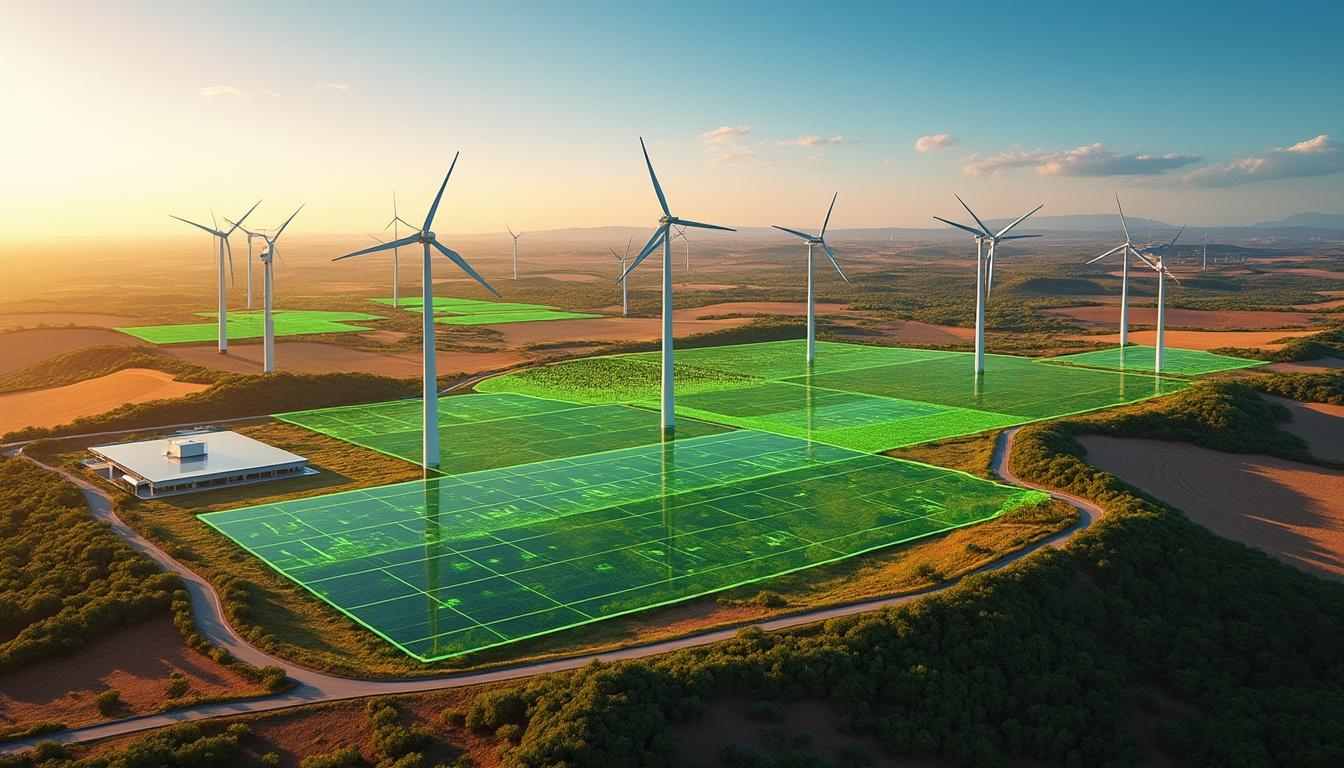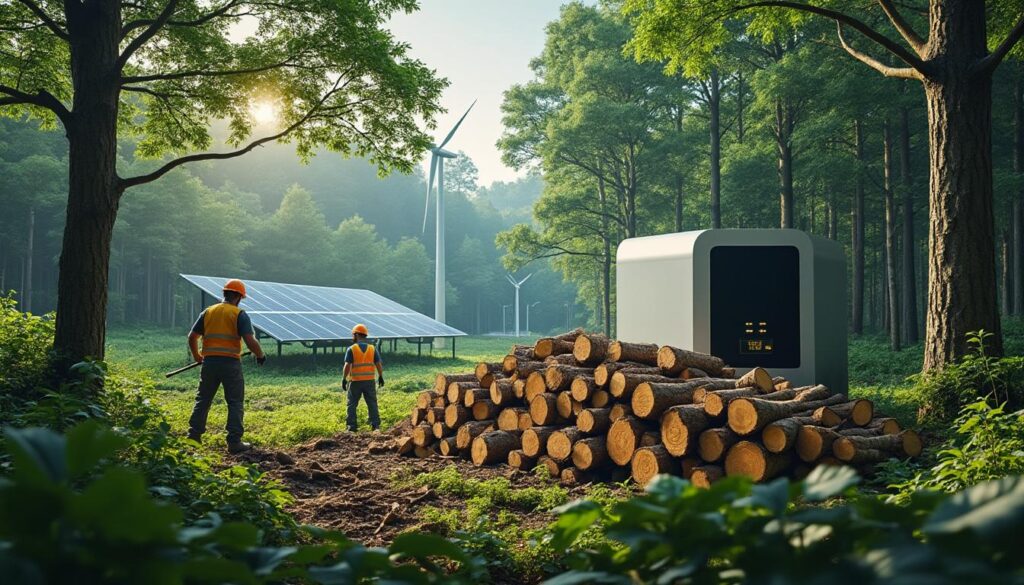Portugal is preparing a “green map” to guide solar and wind projects to areas with lower sensitivity and more predictable licensing. The proposal promises to accelerate the energy transition without losing sight of environmental protection and local quality of life.
If you want to quickly understand the practical impact, the table below summarizes the essentials.
| Short on time? Here’s the essentials: ⏱️ | |
|---|---|
| ✅ Key point | Useful detail |
| ✅ More agile licensing ⚡ | ZAER reduce deadlines and bring predictability while maintaining environmental safeguards. |
| ✅ Clear method 🧭 | Cross-mapping of ecological sensitivities, electrical grid, and land use. |
| ✅ Avoid common mistakes 🚫 | Do not proceed without strategic environmental assessment and monitoring indicators. |
| ✅ Bonus for communities 🤝 | Sharing benefits, agrivoltaics, and local participation from the outset. |
Green Map and ZAER: what changes in renewable energy licensing
The Ministry of Environment and Energy presented the team that will design the Green Map to identify Accelerated Zones for Renewable Energies (ZAER) on the mainland. Coordination is led by Maria do Rosário Partidário from the Instituto Superior Técnico, with a final report expected by the end of the 1st quarter of 2026. The goal is simple: to accelerate licensing and reduce uncertainties, without neglecting territorial and environmental restrictions.
The process responds to two recent impulses. First, the strengthening of the security of the National Electrical System after the Iberian blackout of April 28. Second, the transposition of the European Renewable Directive (RED III), which encourages acceleration zones to scale up green production. At the same time, the European Commission has opened infringement procedures against Portugal for failures in simplifying project assessments, making the Green Map a key piece in restoring regulatory confidence.
How the acceleration zones work
ZAER prioritize areas with lower environmental sensitivity and better grid connectivity. The selection crosses ecological mapping, easements, and electrical grid loads, along with agricultural, forestry, and urban land uses. The logic is to avoid conflicts and accelerate projects with lower impact risk.
In licensing, the keyword is simplicity with rigor. Procedures must be shorter and more transparent, but they require monitoring and enforcement capacity for safeguards to function. The association GEOTA argues that the path only works with participatory planning and robust strategic environmental assessment.
- ✅ Focus on “less sensitive” areas 🌿: priorities where ecological risk is lower and the grid is closer.
- ✅ Predictable deadlines 📅: reduction of dead times with clear windows for opinions and decisions.
- ✅ Transparency for investors 💼: public criteria, accessible maps, and stable rules.
- ✅ Active safeguards 🛡️: monitoring with clear indicators and mandatory mitigation plans.
Expected results and European context
Portugal already ranks among the European leaders in renewable electricity and recorded 65.6% renewable electricity production in 2024. The challenge, however, goes beyond generation: it is necessary to achieve 51% of renewables in gross final consumption by 2030, reduce fossil subsidies, and strengthen energy efficiency. The Green Map acts here as an accelerator and quality filter, with a direct impact on the PNEC 2030.
| 🧩 Element | 📌 Practical implication | 🎯 Benefit |
|---|---|---|
| ZAER | Faster licensing in pre-validated areas | Lower risk and lower capital cost |
| RED III | European directive to accelerate renewables | Alignment with climate targets 🌍 |
| Monitoring | Public ecological and social indicators | Credibility and local acceptance |
In summary, the Green Map is a “smart filter” that shortens the path for good projects and avoids missteps. The next piece of the puzzle? Ensuring that the selection methodology is clear and participatory.

Environmental and territorial criteria: identifying privileged zones without harming the territory
For ZAER to fulfill its promise, the selection needs technical rigor and territorial sensitivity. The groundwork involves mapping protected habitats, ecological corridors, easements, cultural heritage, water resources, and climate risks, in addition to grid capacity and urban planning context. This is where reports like GTAER, focused on less sensitive areas, and tools like WEBMAP EPE (with georeferenced energy planning bases) are valuable.
On the social side, it is crucial to consider traditional land uses, nature tourism, landscape, and agricultural heritage. Past mistakes — like solar areas approved without adequate sensitivity criteria — have generated avoidable conflicts and litigation. With the Green Map, the priority is to anticipate risks and design mitigations from the start.
What to observe on the ground
Some criteria gain weight due to their direct influence on impact and viability. Energy evacuation capacity reduces curtailment. Ecological connectivity and avifauna dictate measures such as buffers for wind projects. In agricultural areas, agrivoltaics can reconcile production and agricultural income.
- 🌱 Biodiversity in focus: ecological corridors, habitats, and migratory birds require buffer zones and seasonal mapping.
- 🏞️ Landscape and heritage: frame parks within the topography, avoiding iconic ridgelines and sensitive horizons.
- 🔌 Electrical grid: proximity to substations and lines, reducing costs and technical losses.
- 🚰 Water and soils: protect water intakes and fertile soils; prioritize the occupation of degraded areas.
- 👥 Communities: early participation, transparency, and tangible local benefits.
Practical evaluation method
To transform criteria into consistent decisions, a simple scoring grid is helpful, with adjustable weights according to the territory. The table below illustrates a structure that can be used by municipalities and promoters for initial screening.
| 🧪 Criterion | ⚖️ Weight | 📈 Scale | ✅ Recommended target |
|---|---|---|---|
| Biodiversity | 30% | 0–5 (lower–higher sensitivity) | ≤ 2 in critical areas |
| Grid capacity | 25% | 0–5 (worst–best access) | ≥ 3 near substations |
| Land use | 20% | 0–5 (protection–degraded) | Prioritize degraded areas ♻️ |
| Landscape and tourism | 15% | 0–5 (high–low visual impact) | Avoid iconic views |
| Local acceptance | 10% | 0–5 (opposition–support) | Promote shared benefits |
Adopting a grid with weights and targets makes decisions more defensible and helps explain why an area is included (or not) in the ZAER. Technical transparency is a powerful antidote against unnecessary conflicts.
Local benefits and good neighborliness: how communities and promoters gain
ZAER only works well when communities feel they gain from the transition. This means shared benefits, clear information, and real participation from the beginning. In the territories, success hinges on transforming parks into useful infrastructures — not just units of electricity production.
Consider the case of the “Serra do Vale Cooperative,” an agricultural community with gentle slopes and favorable solar exposure. With an agrivoltaic project, the cooperative installs rows of elevated panels, allowing rain-fed crops below, creating shading during heat peaks and generating complementary income that finances water efficiency.
Shared benefit models that work
There are solutions that align interests, reduce contestation, and create lasting value. The secret is to make the flows of benefits predictable and auditable, with simple contracts and measurable targets.
- 🤝 Local tariffs or “energy discounts” for nearby residents.
- 🌾 Agrivoltaics and fair leasing of agricultural land.
- 🏫 Community funds for schools, health, and energy efficiency.
- 🚴 Trails, shelters, and shading as public use infrastructure.
- 🧠 Training programs and local employment in maintenance and operation.
| 🤲 Model | 💡 Practical example | 🎁 Value for the community |
|---|---|---|
| Revenue sharing | 1–2% of annual revenue for local fund | Predictability and social projects |
| Agrivoltaic | Elevated panels with crops and grazing | Dual use of land 🌱 |
| Energy discount | Reduced tariff in collective self-consumption | Lower bills 💶 |
Smart participation and clear communication
The best projects start with open meetings, simple maps, and a narrative of concrete advantages. A milestone calendar, with deadlines and decision points, builds confidence and reduces noise. Inevitable question: how to follow good examples? Documented videos and experiences help.
To see cases and techniques of territorial integration, it’s worth researching recent references of solar and wind projects focused on landscape and public participation.
When benefits are clear and people participate, projects cease to be “impositions” and become local development opportunities. This is the foundation of good energy neighborliness.
Electrical grid, storage, and investor confidence: from theory to execution
Accelerating licensing only creates value if the energy can be reliably evacuated. This requires upgrades to the electrical grid, reinforcement of substations, and investment in storage. International programs like REI – Renewable Energy Integration show the importance of combining renewables with modernized grids and battery systems to ensure energy “where and when needed.”
Tools like WEBMAP EPE can assist promoters by crossing georeferenced planning data, avoiding surprises in routing and evacuation capacities. On the regulatory side, addressing the infringements pointed out by Brussels in assessment and simplification is vital to reduce country risk and capital costs.
Checklist for promoters and municipalities
Below is a pragmatic roadmap for making the right steps from day one. The sooner the technical coordination, the fewer revisions and conflicts.
- 🛰️ Pre-screening with maps: cross-reference environmental sensitivity, grid, and easements.
- 🔁 Technological flexibility: plan for trackers, agrivoltaics, and distributed storage.
- 📑 Mitigation dossier: buffers, wildlife passages, and landscape plan from the preliminary study.
- 🧭 Public timeline: milestones, deadlines, and contact channels for the community.
- 🔎 Independent audits: reinforce credibility and access to green financing.
| ⚠️ Risk | 🛠️ Mitigation | 📊 Indicator |
|---|---|---|
| Curtailment | Storage + substation reinforcement | % energy fed into the grid |
| Local contestation | Shared benefits and co-planning | Number of community agreements 🤝 |
| Licensing delays | ZAER + timeline with SLA | Average approval time ⏳ |
Want to explore grid-storage integration solutions based on international experiences? Search for technical presentations focused on system operation with high penetration of renewables.
Execution requires engineering, data, and regulatory discipline. With these pillars, the Green Map becomes synonymous with technical and financial security.
From PNEC 2030 to practice: metrics, monitoring, and next steps
Portugal has entered a decisive phase: transforming the goals of the PNEC 2030 into concrete works, with public monitoring. In 2024, renewable electricity reached 65.6%, and the ambition now is to consolidate the electrification of consumption, cut fossil subsidies, and raise efficiency. The association GEOTA emphasizes that success depends on rigorous strategic environmental assessment and clear ecological indicators.
There is inspiration beyond borders. In Brazil, the bet on renewables and bioeconomy is seen as a driver of green jobs and long-term investment. In Angola, the “New Renewables” strategy reinforces the hydropower base as support for the system. These examples show that the transition works when policies, grids, and financing go hand in hand — exactly the premise of the Green Map.
Metrics that matter
Measuring is what guarantees credibility. Simple, public, and annually comparable indicators allow for adjusting the course and quickly correcting on-the-ground issues. The table below summarizes a recommended minimum set for municipalities and promoters.
| 📏 Metric | 🎛️ How to measure | 🎯 Signal of success |
|---|---|---|
| Licensing time | Business days per phase | Continuous reduction year on year |
| Ecological quality | Indices of fauna/flora and connectivity | Stability or improvement 🌿 |
| Social acceptance | Surveys and participation in hearings | Increase in local support |
| Integration into the grid | % of curtailment and grid alarms | Sustained decrease 🔌 |
First steps for you to take today
Municipalities, promoters, and landowners can accelerate learnings now. The platform Ecopassivehouses.pt gathers practical content on landscape integration, ecological materials, and collective self-consumption — useful for turning ambition into well-accepted works.
- 🗺️ Gather local mapping and pre-screen areas based on the criteria on this page.
- 📣 Schedule a public session with simple maps and proposed local benefits.
- 🔋 Study storage and self-consumption solutions to reduce peaks and losses.
- 📜 Define a standard benefit-sharing contract, with clear values and deadlines.
- 🧭 Publish a realistic timeline, with responsibilities and decision points.
If you have little time, start with one action: schedule the first meeting with the community today and bring a clear map of the options. A good start is worth half the journey in quality energy transition.
Source: www.publico.pt


